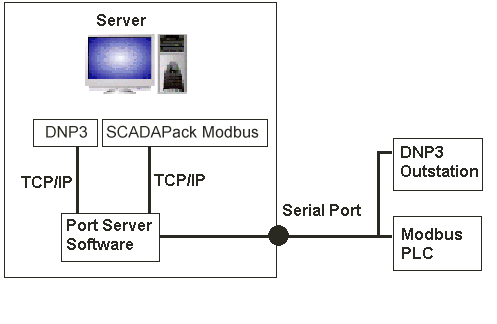Port Server for Port Sharing
You can install the port server software on a ClearSCADA server or remote PC (or use the in-built port server software on SCADA Pack ES) to allow a single port to be used for communications using multiple protocols. This is especially useful on a SCADA Pack ES as there are a limited number of ports available.
There are two possible topologies for port sharing:
- ClearSCADA server or SCADA Pack ES using port server for port sharing

- Remote PC using port server for port sharing

The port server setup for port sharing works as follows:
- The drivers in the ClearSCADA server communicate with the Port Server software via a TCP/IP link. The TCP/IP link can be a connection to a remote PC that runs the Port Server software or can be a link within a ClearSCADA server or a SCADA Pack ES (the ClearSCADA server/SCADA Pack ES runs the Port Server software).
- The Port Server software allows a serial port on the ClearSCADA server/SCADA Pack ES/remote PC to be used for communications with multiple protocols.
- The communication device that is connected to the port (radio etc.) is used to send and receive data to and from the outstations and other devices.
The port used for communicating via many different protocols is set to dynamic mode. This allows different ClearSCADA drivers to communicate via a single serial port. For example, the DNP3 driver and Advanced Modbus drivers can both communicate via the same serial port even though they use different protocols.
When the port server receives data from an outstation or similar device via the serial port, it places the incoming data in a buffer. It then checks the incoming data for specific protocol signatures—when it recognizes the protocol, it sends the data to the relevant driver in the ClearSCADA server via a TCP/IP connection. Similarly, when the port server receives data from a driver in the ClearSCADA server, it places the data in a queue before sending the data to the relevant outstation. By default, there is a delay of 50ms between each message that is sent. This delay can be changed by altering the registry setting:
- Use Regedit to access the PortServer registry settings:
On a 32-bit system:
HKEY_LOCAL_MACHINE\SOFTWARE\Schneider Electric\ClearSCADA\PortServer
On a 64-bit system:
HKEY_LOCAL_MACHINE\SOFTWARE\Wow6432Node\Schneider Electric\ClearSCADA\PortServer
- Change the InterMessageDelay.
To configure a port server for port sharing:
- Install the Port Server Software.
- In ClearSCADA, configure a direct channel of the relevant type for each protocol that is to be used by the serial port. Configure the direct channels are so that their:
- Connection Type is set to Remote Serial
- Node Name is set to:
- localhost (when the port server is installed on the ClearSCADA server/a SCADA Pack ES)
- The name/address of the remote PC (when the port server is installed on a remote PC).
- Port is set to the same port on each channel (this has to be the port that is to be shared)
- Shared setting is enabled.
You will need to configure one channel per protocol and should apply the same settings to each of the channels (Baud Rate, Data Bits etc.). The channels can be of any of the following protocols:
- DNP3 (including WITS)
- IEC 60870 (101 and 104)
- Modbus ASCII
- Modbus RTU (including Advanced Modbus, SCADAPack Modbus, and SCADAPack Realflo).
For more information, see Create the Channels in the Database.